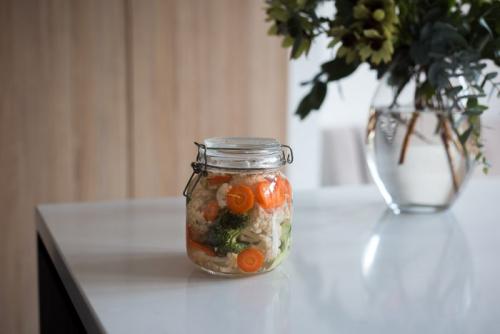A Beginner’s Guide On How To Make Fermented Vegetables

There is no better time to make homemade fermented vegetables than the onset of spring when the gardens are bursting with delicious bounties. It is not possible to eat all the fresh vegetables before they go bad hence the need for preservation. Freezing is good but fermenting is even better. Fermentation is one of the oldest methods of preserving food.
Which are the best vegetables for fermentation?
All veggies and a vast majority of fruits are good for fermentation. The power behind the conversion of the veggies into nutritious meals and beverages lies in lactobacillus bacteria that are found on the outer walls of these foods.
It is advisable to assimilate a number of ingredients including cauliflower, green beans, garlic, carrots, pearl onions, broccoli, and peppers. The possibilities are limitless.
The process of fermenting vegetables
Basically, fermentation is a form of pre-digestion that occurs when lactobacillus bacteria act on foods by breaking down the present starches. In the process, lactic acid is produced and it hampers the development of putrefying bacteria which makes the vegetables go bad. The fermented vegetables can stay for months and even for a whole year. The lactic acid, therefore, maintains the life of vegetables and fruits which end up having a sour taste. Fermented food is advantageous for the digestive system because it facilitated the development of healthy gut bacteria.
The essentials of vegetable fermentation
The process can be divided into two: wild ferment and controlled ferment. The wild mechanism is when the bacteria that occur naturally on vegetables are allowed to do their job without modifications or a culture. The controlled method entails the addition of culture to give the food some head start.
A container is required to accommodate the ingredients e.g. a mason jar or fermenting crock. For the controlled fermentation, a starter or culture is needed which may be in form of liquid whey, kombucha, probiotic capsule, or a liquid from previously fermented vegetables
Salt is also necessary to add flavor and maintain the crunchiness. Salt is also anti-microbial and will thus inhibit the growth of bad bacteria. All the veggies should be put inside the container and liquid (brine, starter, and salt) added to cover them completely to ensure anaerobic activity. After tightening the lid, the mixture is left to ferment at room temperature for 1-5 days depending on the flavor requirements.
Vegetable fermentation results into a number of products such as jams and chutney, fruit soda, sauce, wine, juice, kimchi, liquor, sauerkraut, and so on.
Advertise on APSense
This advertising space is available.
Post Your Ad Here
Post Your Ad Here

Comments